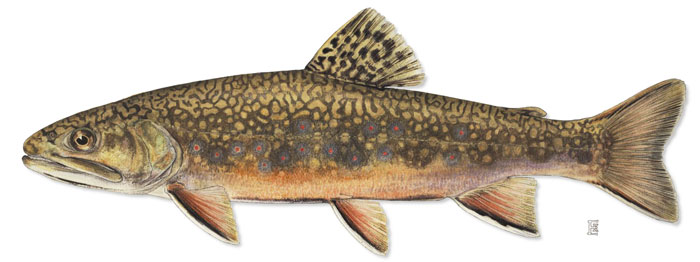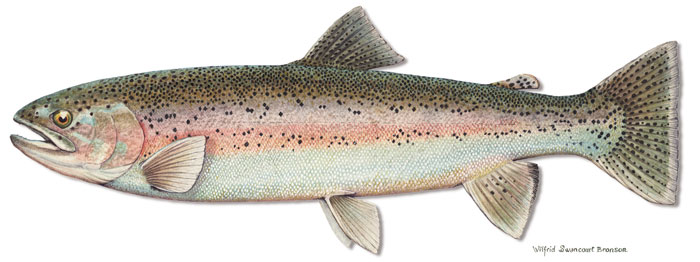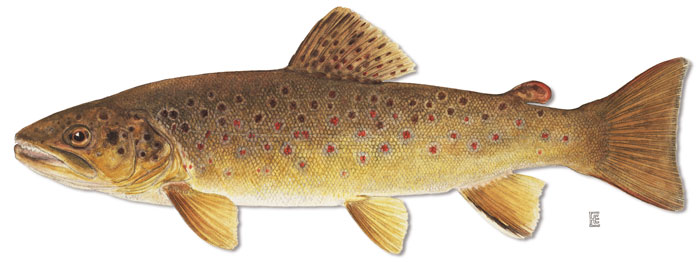Catskill Trout
The Esopus Creek watershed upstream of New York City's Ashokan Reservoir is home to three species of wild trout: rainbows, browns, and brook trout. The spring runs of rainbow trout up out of the Ashokan, and also fall runs of browns — both species on their annual spawning migrations — are what the Esopus is best noted for. In fact, on May 31st, 1913 Theodore Gordon, the father of American dry-fly fishing wrote the following about the Ashokan Reservoir and Esopus Creek connection,
"By the way, the new Shokan dam, in the Catskills, will afford the finest trout fishing in America, if properly treated, and not spoiled by the introduction of other predatory fish. It will be stocked naturally from the Esopus with the rainbow and European trout of good size and quality."
Brook Trout (Salvelinus fontinalis)

Prior to the introduction of rainbow and brown trout, in the days before tanning was a major Catskill industry, this native NYS fish was the prominent species found in the top sections of the watershed, although brook trout are actually char and not trout at all. For the most part nowadays brook trout have been remanded to the upper reaches of the Esopus Creek and all its tributaries as they require the coldest and purest wild quality of the three species. A wild six-inch "brookie" would be a good fish, a nine-incher trophy-like. Brook trout are opportunistic feeders, but like all wild fish require "angling stealth" if the flyfisher is to be successful. In their autumn spawning attire, with plump melon-color bellies and fins edged chalk-white, wild brook trout are truly a sight to behold.
Rainbow Trout (Oncorhynchus mykiss)

Without a doubt, among flyfishers the Esopus is best known, and loved, for its wild rainbow trout and with good reason. In the days of Preston Jennings through the 1950's and '60's, outdoor columnists regularly reported on spring-run rainbow trout with some in the twenty-eight to twenty-nine inch lengths. Sadly with the demise of emerald shiners in the Ashokan Reservoir, these large bows disappeared also. However, wild rainbows are still the "main attraction" for the Esopus. They were first introduced into the Esopus Creek watershed in the 1883 as a private stocking, but since 1952 the NYS Department of Environmental Conservation (DEC) has only stocked brown trout; all of today's rainbow trout are wild fish and originally were of west coast descent.
These days rainbows in the six-to-twelve inch range are typical with a few spawning bows pushing twenty inches or more. They are often referred to as "silver bullets" for their chrome sides with a broad crimson side. They are spirited fish, robust jumpers with larger bows that will readily rip line from the angler's reel causing it to sing. Flyfishers offering these bows the correct nymph, wet, or dry fly under appropriate conditions will often be rewarded with an experience the Esopus Creek is known for. Rainbow trout are found throughout almost the entire watershed, the exceptions being the headwaters of the Esopus and upper reaches of tributaries.
Brown Trout (Salmo trutta)

Esopus Creek watershed Brown Trout emanate from two sources: the hatchery and wild fish. Every spring NYS DEC stocks several thousand browns into the Esopus and Ashokan. This trout species was initially introduced into the watershed sometime after the first stocking of rainbows, and have since established themselves as wild fish also. There is an excellent population of wild browns throughout the entire watershed; in fact many of the browns caught in tribs are wild fish with colorful dappled dark and red spots. All brown trout found in the U.S. have a European heritage.
Perhaps the two most renowned trout ever caught in the watershed were both brown trout. In 1923 T.E. Spencer caught a 19 pound, 14 ounce brown trout in Chimney Hole that remained the NYS record for thirty-one years. And, in 1955 Larry Decker caught Old Bess, a 9½ pound brown that made Mother's Pool its home. Anglers these days catch a good number of eight-twelve inch brown trout, yet once again larger fish will reach the twenty-inch mark and a few thirty inches, or better. For the most part these big browns are typically part of an autumn spawning run. Brown trout, that are feeding, will readily take all types of flies—nymphs, wets, dries, and streamers—when properly presented.
By Ed Ostapczuk
Fish watercolors courtesy of The New York State Department of Environmental Conservation. The paintings were part of a biological survey done in the 1930s. More can be seen on the DEC's website.




